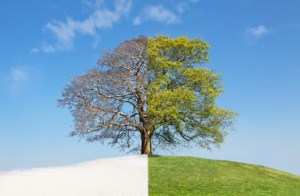
When a seasonal affective disorder is discussed, it is usually about an Autumn/Winter SAD concern. Many people deal with SAD during the colder months of the year because there is less sunshine, fewer chances to get outside and be comfortable without heavy clothing, and fewer socialization opportunities. This can create symptoms that are like depression or a bipolar disorder.
It is a condition that affects up to 6% of the general population on an annual basis.
About 1 in 10 people experience their seasonal affective disorder in reverse. For them, it occurs in the Spring and Summer instead. There is even some evidence to suggest that a person is more likely to experience Spring/Summer SAD when they live closer to the equator.
Are there differences between these two versions of SAD?
Spring and Summer SAD Involves Different Depression Triggers
If you deal with SAD in the Autumn or the Winter, then many of your symptoms are triggered by the changing days. With less sunlight and fewer opportunities to get out of the house, it is very easy to feel restless. That uneasiness can translate into depression-like symptoms, which, if left untreated, may even develop into something more serious.
SAD in the Spring or the Summer involves a different trigger. The seasonal changes cause routine disruptions that can be bothersome to some people. This is especially true for parents of school-aged children, who suddenly have a complete change of their routine for 3+ months until school starts again.
And if your kids are in college, you might find all their stuff back in your house after a 9-month absence.
There are also body image concerns that can trigger SAD in the summer. If you don’t feel good about your body, but it’s too warm to cover it up, then the embarrassment of being in a bathing suit, shorts, or a tight t-shirt can be enough to trigger symptoms.
There are financial concerns that come in the Summer as well, like being able to afford a vacation or providing activities for your children. Those expenses can be a trigger for depression.
The heat of Summer must also be considered. Not everyone enjoys being hot and sweaty, even if it is a beautiful day.
How to Treat Summer SAD vs. Winter SAD
If you deal with SAD during the Autumn and Winter months, then daily light therapy can help to reduce or eliminate your symptoms. You may also receive treatment and therapy from local doctors and counselors to find your balance.
For Summer SAD, it can be helpful to plan ahead so you’re not caught off-guard by unusual expenses. Consider adding exercise to your winter routine so that there are fewer body image concerns. It is also necessary to get the right amount of sleep every night, which can be difficult to do during the longer days of Summer.
Consider using a sunrise alarm to balance out your circadian rhythm if a lack of sleep is triggering your Summer SAD symptoms. It will simulate a natural cycle of light, but at a time you prefer. All you need to have is a darkened room to promote healthier sleep.
A seasonal affective disorder can strike at any season. The symptoms may be similar, but the triggers can be quite different. By recognizing the potential for SAD and seeking out treatment right away, you can reduce the signs and symptoms of this disorder and take back control of your life.




















